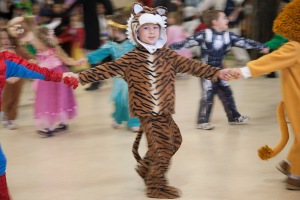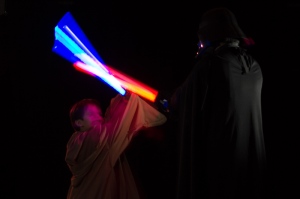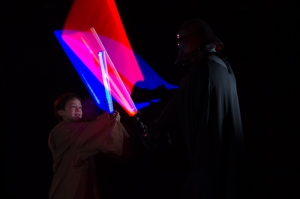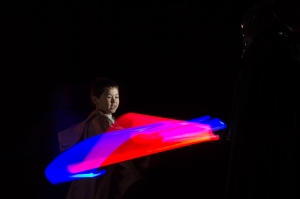I was asked a very good question about how slow one could set the shutter speed and still freeze the motion with flash. As is the case with many good questions, the answer is complicated. It depends.
When I was in the earlier stages of learning to use a flash at events, I read an article by a well-known wedding photographer that said his go-to settings were f/4.0 and 1/40 second. I tried adopting this method, and sometimes it worked well, but at other times it gave very disappointing results. I came to realize that the factors that led to a lot of visible motion blur were not only the speed of movement of the subject, but also the amount of ambient (existing in the environment already) light in the scene. If there was enough light in the environment to give an image that was only slightly underexposed without flash, then that blurred image would be fairly prominent, and the superimposed sharp image contributed from the flash wasn’t enough to dominate the image.
You can clearly see in the above photo the faint sharp image is dominated by the blurred image.
However, in the Jedi arena, there was very little ambient light, with the major ambient light source being the lightsabers. The combatants were very active, but I used a shutter speed of 1 second. (Normally, if the photo was lit only by ambient light, I would want a shutter speed of around 1/500 second to freeze the action.) There were three flashes surrounding the subjects, activated by radio triggers from my camera, but as the subjects moved, the amount of flash reaching the faces varied.
In the photo below, Darth Vader is blocking the flash from reaching the Jedi’s face. The face is lit by a one second exposure from the combined lightsabers, and is quite blurry. Darth Vader’s back, by contrast, lit by the flash, is quite sharp.
However, when they shift positions slightly, as in the below image, the flash can now reach the Jedi’s face, and it is much more clear. You can see the ghost blur, but it doesn’t dominate the image, and it can be easily cloned out.
In the image below, the lightsabers were lower than the faces so they cast little light on the faces, and the flash wasn’t obstructed from reaching the face at all, so we had a very sharp image of the face, with the blur only seen on the hood of the robe lit by the blue lightsaber.
So you can see that when you use a long exposure with flash, your image will be a combination of the sharp image lit by flash and the blurred image lit by the ambient light. The more ambient light there is compared to the flash, the more of the blurred image will be visible. If you use longer shutter speeds, you can collect more of the ambient light in your image over the longer exposure time, which can be good or bad, depending on your desired results.
Here’s a last little thought to explode your brain. If you don’t want the ghost blur to show up, often you are better off having the subject move faster, rather than slower. Can you figure out why?














Great article Nancy! A fun technical read. 🙂
Hooray! Someone else who thinks “fun” and “technical” belong together in the same sentence!